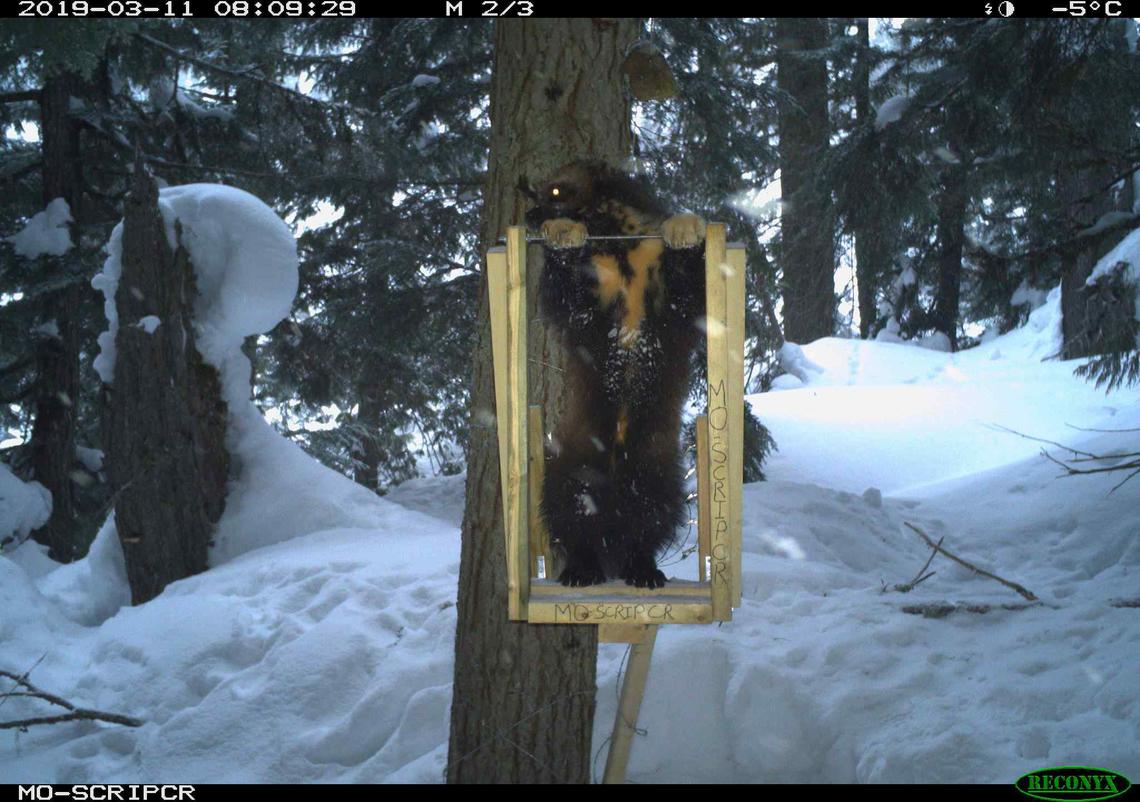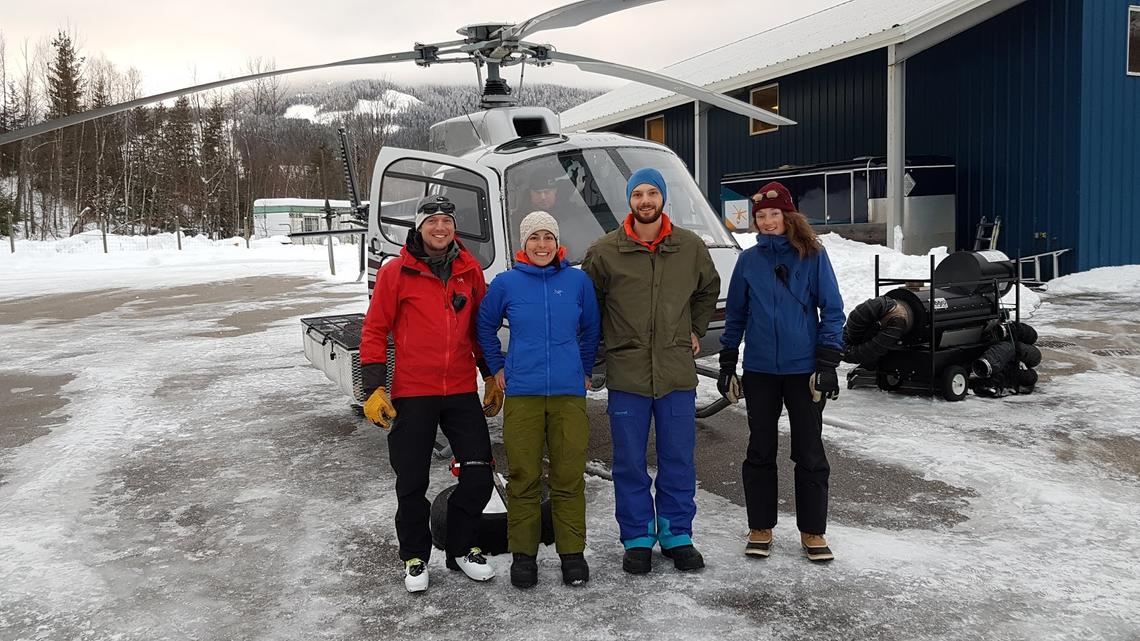
Wolverines have unique fur patterns. Barrueto used these to help identify individual wolverines.
Oct. 23, 2019

At the mention of a wolverine, most people conjure up the fearsome legend of comic book lore. While the real creatures are just as tough, they are also elusive and solitary, adding to their air of mystery.
The “cool factor” of the mountain-dwelling mammal (who are members of the same family as otters, weasels, and badgers, but more resemble a small bear) is certainly a part of what motivates Mirjam Barrueto, a PhD student working with Dr. Marco Musiani, PhD, in the Department of Biological Sciences. She began her PhD in 2017, working with Musiani’s group to study how human activities impact wolverines, specifically breeding females.
Her work will be showcased in Chasing a Trace, a documentary by award-winning filmmaker Leanne Allison, at the Banff Film Festival on Oct. 26.
Partnerships key to conservation efforts
After finishing her MSc in zoology at the University of British Columbia, Barrueto — for whom becoming a scientist was a lifelong dream — became involved with a project led by Dr. Tony Clevenger of Montana State University that monitored the wildlife crossing structures along the TransCanada highway, and analyzing the crossing data. From there, in 2011, she began working on winter wolverine surveys, and grew more and more interested in wolverine conservation. She started her PhD project with Musiani in 2017, planning to continue and formalize wolverine observations in the region.
“We had done six years of population surveys and got a good idea on numbers and some of the problems they’re facing in the region, but what was now needed, since they have such low density and slow reproduction, was information on breeding female distribution and breeding females’ habitat selection at the landscape-scale. Where do they live? How many are there? How do they interact with the built environment? Musiani was fundamental in helping me put the applied research into an ecological context,” says Barrueto.
“We’re trying to count wolverines because the species was considered of “special concern” under the Species at Risk Act in 2018,” Musiani says. “We’re losing the connectivity of wildlife populations, and wolverines are telling that story.”

Wolverines have unique fur patterns. Barrueto used these to help identify individual wolverines.
Wolverines live over a vast territory in North America and tend to make their habitats in remote, snowy areas. They are exceedingly rare, and seldom spotted by the average mountain-goer. Barrueto, however, was acquainted with several heli-ski guides, who often observed, and told her about, wolverine tracks during their flights over the Columbia and Rocky Mountain ranges in B.C. and Alberta.
Barrueto’s project observes wolverines over an area measuring 50,000 square kilometres in the Columbia and Rocky Mountains covering parts of eastern B.C. and western Alberta. It is the first wolverine study looking specifically at females that is being done at such a large scale.
Fortunately, partners with Parks Canada, B.C. Parks, the Yellowstone to Yukon Conservation Initiative, the Habitat Conservation Trust Foundation and many members of the helicopter and cat skiing industry in B.C. were willing to help Barrueto by sharing data, providing funding and donating flight time to help with her research.
“The people I knew in the heli skiing industry, and backcountry skiers, told me that they had collected quite a bit of wolverine data, and they shared that nobody had ever looked at it. I started talking with some of the companies about it, and they expressed interest in doing something on wolverines together,” Barrueto explains.
“They wanted to get involved because they love being outside and love being in the mountains. They’re locals who are really connected to the land, and want to be good stewards. Their industry is part of the landscape. They are potentially in a position to disturb the breeding females, or work in a way to not disturb them, but from what we know about wolverines, there are a lot of factors that may be important in determining where you’ll find them — for example, I’m also looking at forestry practices, roads, and the potential distribution of predators.”
With the help of community partners, Barrueto has been successful in detecting over a hundred different wolverines so far, 25 of which are breeding females, using non-invasive methods such as setting up cameras and doing genetic work based on hair samples found at observation sites. The last of three planned field seasons is scheduled for 2020.
“We are finding them in many of the places the ski guides said they would be,” she says. “They also helped me with finding safe spots for the observation stations. We’ve been really successful working on the ground with the ski guys.”

Barrueto (second from left) and her field team.
Sharing information helps increase impact
Since her study covers such a large area, Barrueto says that integrating data beyond the ‘hard science,’ and sharing results with local communities, is an important part of research.
“I’m working with stakeholders as collaborators, and learning how to work with knowledge that may not necessarily be scientific. The science is an important but tiny part, especially in conservation,” she says. “But unless you’re willing to listen to what others have to say, and consider that what they have to say may be correct and may have value, they may not listen to what you have to say either. As a conservation biologist, I have to be willing to go there, not just to talk about the results, but to also talk about the process to prove that what we’re doing has value.”
It was through her community relationships that Barrueto became connected with award-winning filmmaker Leanne Allison, who had also produced a film on Clevenger’s highway project. Barrueto had hoped to work on a wolverine film for many years, and jumped at the chance to work with Allison when funds for a documentary became available through Yellowstone to Yukon Conservation Initiative (Y2Y) and the Telus StoryHive.
“I’ve always admired her for her work and for what she does. She knows the area, and even some of the ski industry people that I work with, really well. It was a dream come true,” Barrueto says.
Allison’s film tracks Barrueto as she carries out her research from her home base in Golden, B.C., and hikes through the majestic mountain ranges to track the elusive but vulnerable wolverine.
Thirteen additional screening dates for Chasing a Trace, hosted by Y2Y and Wildsight, are planned for locations across the Kootenay region of B.C. in November.